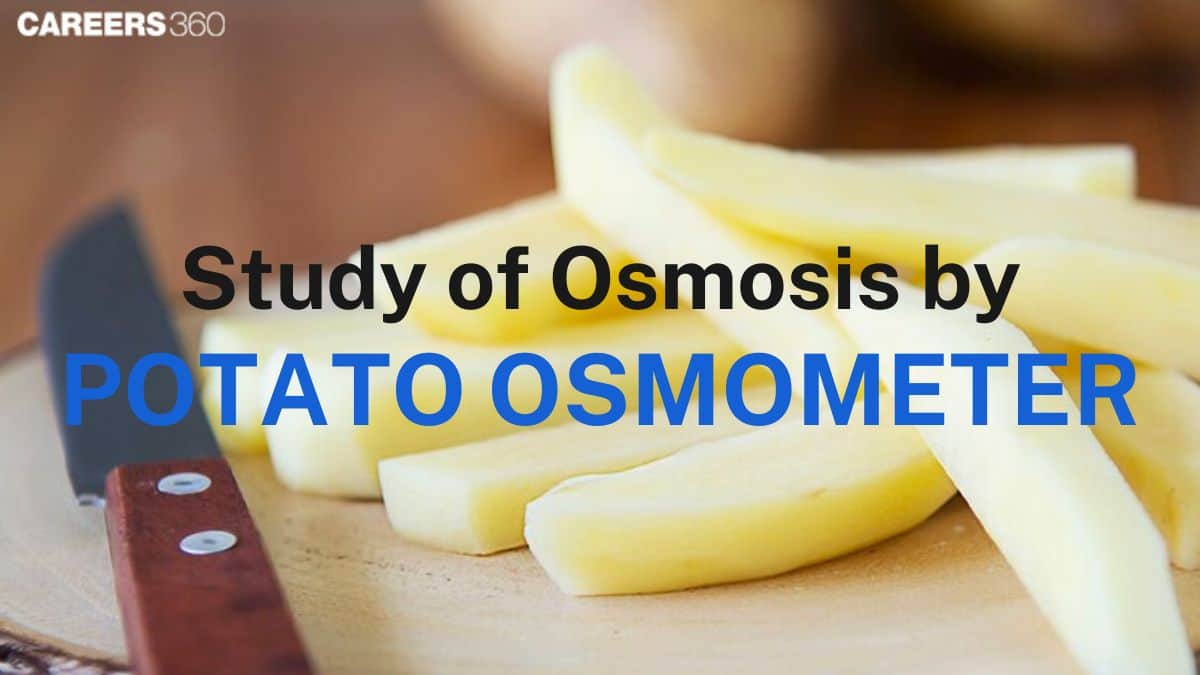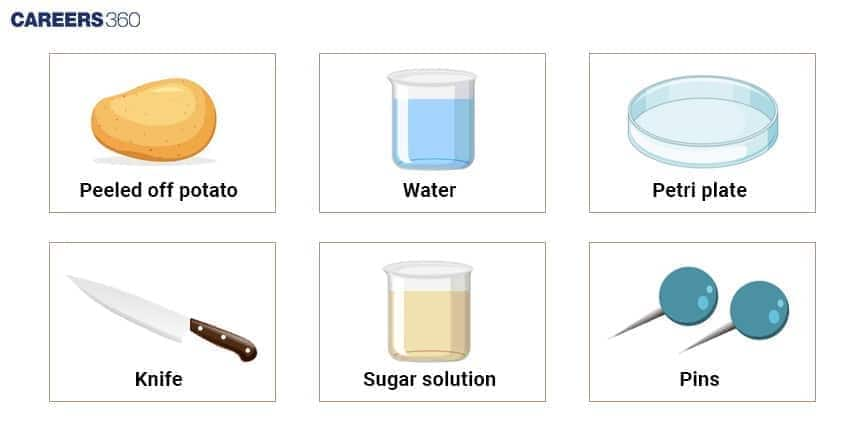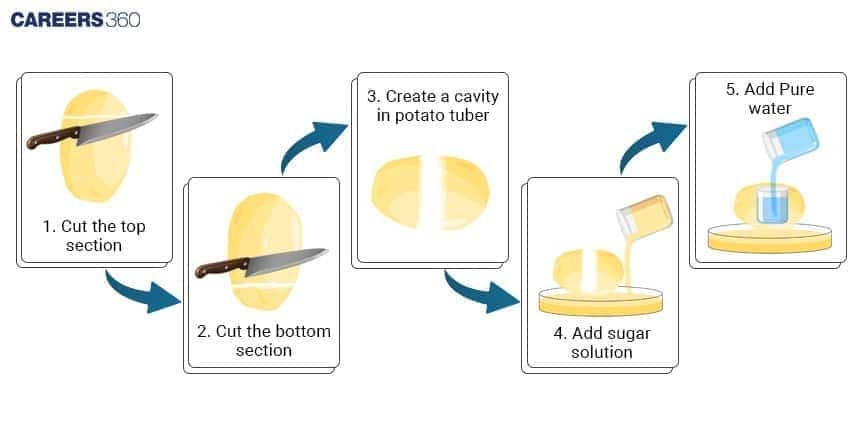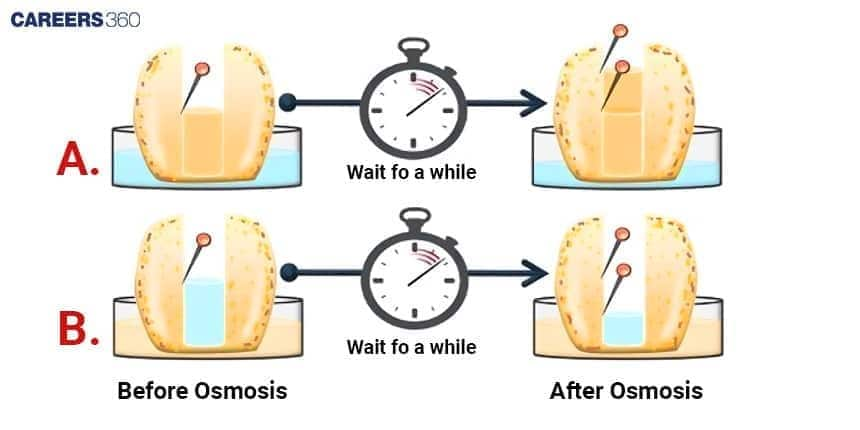Study Of Osmosis By Potato Osmometer: Diagram, Experiment
The Potato Osmometer Experiment demonstrates the process of osmosis using a raw potato, sugar solution, and water. It shows how water moves through a semi-permeable membrane from higher to lower water potential, helping students visualize endosmosis and exosmosis in plant cells. Covers aim, theory, types of solutions, materials, procedure, observation, and conclusion.
This Story also Contains
- Introduction to Potato Osmometer
- Aim of the Experiment
- Theory of Osmosis
- Materials Required
- Procedure (Step-by-Step)
- Observation
- Conclusion
- Applications of Potato Osmometer
- Potato Osmometer NEET MCQs (With Answers & Explanations)
- Recommended video on the "Study Of Osmosis By Potato Osmometer"

Introduction to Potato Osmometer
The potato osmometer experiment is a demonstration used to study osmosis in plant tissues.
What is a Potato Osmometer?
In this experiment, a hollow cavity is made in a peeled potato and filled with a concentrated sugar solution. The potato is then placed in a beaker of water, allowing water to move through the potato’s semi-permeable cell walls into the cavity by osmosis. The resulting increase in volume causes the liquid level in the attached tube to rise, visually proving water movement. This experiment helps students understand concepts such as endosmosis, water potential, and the role of semi-permeable membranes in living organisms.
Principle of Osmosis Demonstration
This movement of water causes the liquid level in the cavity to rise, showing how osmosis works in living cells. The potato cell membrane acts as a semi-permeable barrier and allows water to pass through, but not salt. This experiment helps students understand how plants absorb water from the soil, and osmosis plays a key role in everyday biological processes.
Aim of the Experiment
The aim of the experiment is to demonstrate the process of osmosis in plant cells. It shows how water moves across a semi-permeable membrane (potato cell walls) from a region of higher water potential to a region of lower water potential.
Theory of Osmosis
The theory related to osmosis is explained below-
Definition
Osmosis is the phenomenon where solvent molecules cross a semi-permeable membrane from a more concentrated region to a less concentrated region. It will carry on till the fluid quantity is equal on both sides of the membrane, thus balancing the fluid quantity on either side. In simple terms can be defined as osmosis, the diffusion of water from the high water potential region to the low water potential region.
Role of Semi-Permeable Membrane
The solvent is the fluid which moves through the semipermeable membrane, and the solute refers to the dissolved particles which are present in the fluid.
Types of Solutions
The osmosis by potato osmoscope experiment is an important method of showing the effects of different solutions and understanding the concept of osmosis in biological systems.
Hypertonic Solution: Solution with a high concentration of solute. When a cell is placed in a hypertonic solution, water moves out of the cell because the water potential outside is lower than that in the cell, causing the cell to shrink and become plasmolysed.
Hypotonic Solution: A solution with a low solute concentration. When a cell is placed in a hypotonic solution, water enters the cell due to its higher water concentration outside, making the cell swell and become turgid.
Isotonic Solution: A solution of equal concentration of solute and solvent on both sides of the membrane. Placing a cell in an isotonic solution results in no net movement of water, which allows the cell to retain its original shape.
Solution Type | Solute Concentration | Effect on Potato Cells |
Hypotonic | Low solute, high water | Cell becomes turgid (endosmosis) |
Hypertonic | High solute, low water | Cell becomes plasmolysed (exosmosis) |
Isotonic | Equal solute and solvent | No net movement |
Materials Required
To study by demonstrating the osmosis process by potato osmometer.
Fresh large-sized potato tuber
Sucrose solution of 20% concentration
Beaker
Water
Scalpel or blade
Petri dish
Bell pin needle marked with waterproof ink

Procedure (Step-by-Step)
Cut the potato tuber into two halves using a scalpel or blade. Remove the skin and then cut these halves into square pieces.
Scoop out a small cavity from the mid-region of the potato tuber, having a minimum thickness at the base. The cavity may be square or circular.
Fill half the cavity with freshly prepared 20% sucrose solution and put a pin into the cavity so that its mark coincides with the level of sucrose solution.
Place the potato osmometer in a petri dish or beaker containing water, the level is to be such that 75 % of the potato osmometer will be submerged in the water.
Allow to remain undisturbed for about 1 hour.
Observe and note the level of the sucrose solution in the osmometer at the end of the experiment.
Repeat the experiment with the cavity filled with water and the sucrose solution in the Petri dish or beaker.

Observation
After an appropriate length of time, the sugar solution inside the potato osmometer will rise and may also become coloured. This shows that, on account of osmosis, the water moves inside the osmometer.

Conclusion
The conclusion of the experiment is:
In the potato osmometer experiment, there is an increase in the level of sucrose solution because of the movement of water into the solution through endosmosis.
This process demonstrates osmosis by the potato osmoscope experiment, whereby the water enters the sugar solution through the tissues of the potato and acts as a selectively permeable membrane.
A water potential gradient is developed between the sucrose solution in the potato osmometer and the external water in the beaker.
The selectively permeable membrane of the potato tuber allows water to flow into the sugar solution, even though it is separated by a living potato cell.
The result of this experiment explains that it can be used as a model for the theory of osmosis, for a principle that shows how different water potential gradients can drive water movement.
Osmosis in a potato demonstrates water dynamics in a biological system, and many experiments on osmosis use this potato experiment.
Applications of Potato Osmometer
The potato osmometer experiment helps to study the movement of water in plant tissues through osmosis. It helps in understanding plant-water relations and is widely used for educational demonstrations.
It helps to demonstrate the process of osmosis in plant cells.
It explains the concepts of endosmosis and exosmosis.
It shows how plants absorb water from the soil.
It is useful in teaching plant physiology in schools and colleges.
Potato Osmometer NEET MCQs (With Answers & Explanations)
The key concepts to be covered under this topic for different exams are:
Concept of Osmosis
Types of Solutions
Conclusion of the experiment
Practice Questions for NEET
Q1. Why is an osmoscope used?
To measure the osmotic pressure
To measure the solution pressure
To demonstrate the osmosis
To demonstrate the diffusion
Correct answer: 3) To demonstrate the osmosis
Explanation:
An osmoscope is a device which was designed for the demonstration as well as for the study process of osmosis. Such a device always consists of the semipermeable membrane used to separate solutions of different concentrations. When dipped in a solution, the osmoscope has the ability for water molecules in the area having lower solute concentration to go through the barrier into the solution having a higher concentration of solutes. This activity demonstrates the theories of osmosis, especially how solvent molecules balance the distribution of solutes across a separating barrier.
Hence the correct answer is Option (3) To demonstrate the osmosis.
Q2. Why does the level of solution rises from the initial level in the osmoscope?
Due to exosmosis of pure solvent across the potato
Due to loss of water from the potato
Due to endosmosis of pure solvent across the potato
Due to absorption of water by the potato
Correct answer: 3) Due to endosmosis of pure solvent across the potato
Explanation:
When the potato is peeled and the inner section of it is taken out with the help of a spoon or knife, it becomes U-shaped.
It is then placed in a tray having a pure solvent.
The cavity of the U-shaped potato osmoscope is filled with a 10% solution.
A pin is marked at the initial level of the 10% solution in the potato osmoscope. This pin is labelled as an initial pin.
After 2 hours, the level of the solution in the potato osmoscope will rise. This is endosmosis occurring due to the difference in the concentration of the solution.
Hence, osmoscope is a device that describes the process of osmosis.
The level of the solution in the potato osmoscope rises due to the endosmosis occurring due to the difference in the concentration of the solution.
Hence the correct answer is Option (3) Due to the endosmosis of pure solvent across the potato.
Q3. Why do solvent particles from the pure solvent move toward the solution side in the osmometer?
Due to difference in water concentration
Due to difference in solute concentration
Both a and b
None of these
Correct answer: 1) Due to difference in water concentration
Explanation:
In an osmometer, the particles move in the direction from the pure solvent to the solution side because of concentration differences. To be more specific, osmosis involves moving water molecules to balance out the concentration of a solute on either side of a semipermeable membrane. More importantly, osmosis does not depend on the movement of the solute particles; it relies only on the gradient of water concentration molecules to achieve equilibrium.
Hence the correct answer is Option (1) Due to the difference in water concentration
Also Read:
Recommended video on the "Study Of Osmosis By Potato Osmometer"
Frequently Asked Questions (FAQs)
The potato osmometer experiment shows how osmosis works in living cells. In this activity, a potato is used as an osmometer to demonstrate osmosis. Water from the surrounding solution moves into the potato cells through the semi-permeable plasma membrane, highlighting the natural movement of water during osmosis.